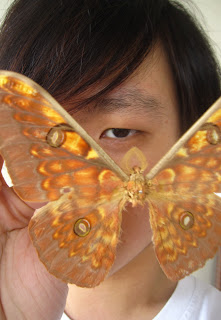Hey guys
If you have been reading my blog you will know that lately, I've had my arms tied paying nursemaid to my poor Cumulus who is now showing some signs of recovery. On the other hand I have also managed to find the time to get some taxidermy done. Recently I had managed to procure for myself a couple of rather spectacular insects and, leaving for Angkor Wat soon, it was extremely urgent that I got to preserving them lest the nasty parasites and fungal growths beat me to their dead bodies by the time I get back!
If you have been reading my blog you will know that lately, I've had my arms tied paying nursemaid to my poor Cumulus who is now showing some signs of recovery. On the other hand I have also managed to find the time to get some taxidermy done. Recently I had managed to procure for myself a couple of rather spectacular insects and, leaving for Angkor Wat soon, it was extremely urgent that I got to preserving them lest the nasty parasites and fungal growths beat me to their dead bodies by the time I get back!
 |
| The three new specimens consisting of a White Cicada, Indian Moon Moth and some sort of Emporer Moth |
 |
| Ayuthia Spectabilis, White Cicada was magnificent in itself |
But, being a lepidopterist, the prize of my collection was, naturally the two large saturniid moths; an Indian Moon Moth and another moth of the "Emperor" Moths.
 |
| And not to forget this majestic male Antheraea Celebensis (common name unidentified) with its fiery wings that I believe to be one of the Emperor Moths |
Some Brief Info on SaturniidaeConsidered by most to be some of the most spectacular of all moths species, the Saturniid Moths boasts some of the largest species of moths in the world including the world's largest lepidoptera, the Atlas Moth. Characterized by their furry bodies, lobed wings and lack of mouthparts Saturniid Moths are also known for their brightly coloured wings which often boast translucent "windows" or eyespots. Similar to most moth species, male moths can be distinguished from female moths by their large and feathery antennae which can be used to detect the pheromones released by female moths for many miles away! The moths, which do not have mothparts live only to mate and then die. These beautiful moths are usually found in wooded tropical or subtropical regions with the greatest diversity in the New World Tropics and Mexico.
 |
| To give you a rough idea on the size of these moths, here's a picture of the Emperor Moth held up against my face! |
Why is it all the cool animals have gone extinct...and the even cooler ones are now endangered...



1 comment:
Very beautiful...the cicada also. You're right about the Indian Moon Moth...what spectacular wings it's got! But I've never seen it before. i only have the smaller ones visiting my yard/front-door steps!
Post a Comment